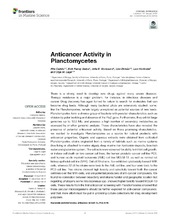| dc.contributor.author | Calisto, Rita | |
| dc.contributor.author | Sæbø, Eirik Færøy | |
| dc.contributor.author | Storesund, Julia Endresen | |
| dc.contributor.author | Øvreås, Lise | |
| dc.contributor.author | Herfindal, Lars | |
| dc.contributor.author | Lage, Olga M. | |
| dc.date.accessioned | 2020-08-14T12:29:37Z | |
| dc.date.available | 2020-08-14T12:29:37Z | |
| dc.date.issued | 2019-01-07 | |
| dc.Published | Calisto, Sæbø, Storesund JE, Øvreås L, Herfindal L, Lage OM. Anticancer activity in Planctomycetes. Frontiers in Marine Science. 2019;5:499 | eng |
| dc.identifier.issn | 2296-7745 | en_US |
| dc.identifier.uri | https://hdl.handle.net/1956/23783 | |
| dc.description.abstract | There is a strong need to develop new drugs against many severe diseases. Therapy resistance is a major problem, for instance, in infectious diseases and cancer. Drug discovery has again turned to nature to search for molecules that can become drug leads. Although many bacterial phyla are extensively studied, some, like the Planctomycetes, remain largely unexplored as potential sources of new leads. Planctomycetes form a diverse group of bacteria with peculiar characteristics such as division by polar budding and absence of the FtsZ gene. Furthermore, they exhibit large genomes up to 12.5 Mb, and possess a high number of secondary metabolites as assessed by in silico genomic analysis. These characteristics have also revealed the presence of potential anticancer activity. Based on these promising characteristics, we wanted to investigate Planctomycetes as a source for natural products with anticancer properties. Organic and aqueous extracts were obtained from cultivated Planctomycetes strains originated from a variety of habitats such as marine systems (free living or attached to marine algae), deep marine iron hydroxide deposits, brackish water and glacier ice system. The extracts were screened for ability to inhibit cell growth, or induce cell death on two cancer cell lines, the human prostatic cancer cell line PC3, and human acute myeloid leukaemia (AML) cell line MOLM-13, as well as normal rat kidney epithelial cell line (NRK). Out of 39 strains, five exhibited cytotoxicity toward NRK cells, whereas 32 of the strains were toxic to the AML cell line, and four were toxic to the PC3 cell line. Two strains showed high toxicity and selectivity toward both the cancer cell lines over the NRK-cells, and are potential producers of anti-cancer compounds. We found no correlation between bioactivity and strains habitat and geographic location but regarding phylogeny some Rhodopirellula spp. showed higher toxicity toward MOLM-13 cells. These results from the first anticancer screening with Planctomycetes showed that these peculiar microorganisms should be further explored for anti-cancer compounds, and that more effort must be put in providing culture collections for drug development purposes. | en_US |
| dc.language.iso | eng | eng |
| dc.publisher | Frontiers | en_US |
| dc.rights | Attribution CC BY | eng |
| dc.rights.uri | http://creativecommons.org/licenses/by/4.0/ | eng |
| dc.title | Anticancer activity in Planctomycetes | en_US |
| dc.type | Peer reviewed | |
| dc.type | Journal article | |
| dc.date.updated | 2019-12-19T08:22:35Z | |
| dc.description.version | publishedVersion | en_US |
| dc.rights.holder | Copyright 2019 The Authors | en_US |
| dc.identifier.doi | https://doi.org/10.3389/fmars.2018.00499 | |
| dc.identifier.cristin | 1646396 | |
| dc.source.journal | Frontiers in Marine Science | |
| dc.relation.project | EU: H2020 - 692419 | |
| dc.relation.project | Norges forskningsråd: 256162 | |

